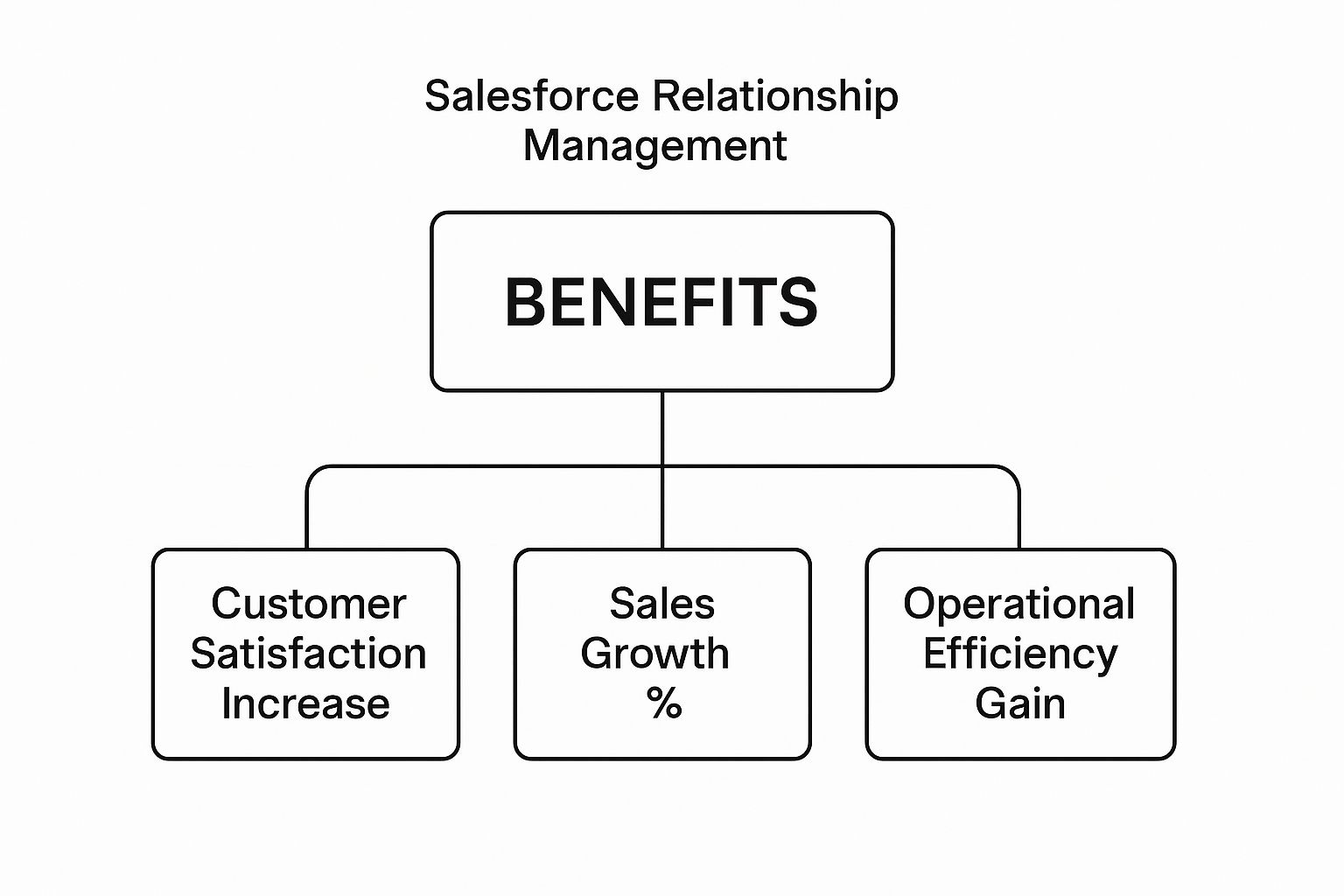Salesforce Relationship Management is much more than a piece of software. Think of it as a strategic philosophy for bringing every single customer interaction together under one roof. It takes all the scattered bits of information from your sales, marketing, and service teams and organizes them into a single, intelligent view of each customer.
Why Salesforce Becomes Your Business's Central Hub
Picture your business as a living, breathing organism. Your sales, marketing, and customer service departments are its eyes and ears, constantly gathering vital information. Without a central system to process it all, that information stays fragmented—a chaotic mess of notes, spreadsheets, and disconnected conversations. This is where Salesforce relationship management steps in, acting like a central nervous system for your entire operation.
It connects every single touchpoint, from the very first marketing email a prospect opens to the most recent service call they made. Instead of data being stuck in silos and creating disjointed experiences, you get a complete, 360-degree profile for every contact. This isn't just about neat organization; it's about fundamentally understanding and responding to every customer's needs with precision.
Escaping the Data Silo Trap
One of the biggest headaches for any growing business is fragmented customer data. When your teams aren't looking at the same information, things start to fall through the cracks.
- Your sales team might try to upsell a customer who has a frustrating, unresolved support ticket.
- Your marketing department could be sending promotional offers to an already unhappy client.
- Your service agents are left in the dark, trying to help without knowing a customer's purchase history.
Salesforce breaks down these walls. It creates a single source of truth that empowers every department to finally work in sync.
This unified approach goes far beyond basic contact management. It lays the groundwork for building deeper, more profitable, and lasting customer relationships—a massive advantage in competitive markets like the UAE.
This trend is picking up speed across the region. A recent report found that a remarkable 81% of executives in the Asia-Pacific area, including the UAE, expect their CRM use to expand beyond just sales and service in the coming years. This shift highlights a deep focus on delivering better customer experiences by improving internal teamwork. You can discover more insights about this APAC trend and what it means for businesses.
The Salesforce platform gives you a clear, actionable dashboard to manage it all.

This kind of interface shows you exactly how different clouds—like Sales, Service, and Marketing—fit together. It gives your team a complete picture, turning abstract data points into real intelligence you can act on.
Exploring the Pillars of the Salesforce Ecosystem
To really get a handle on Salesforce relationship management, you first need to understand its core components. It helps to think of the Salesforce platform less like a single, monolithic tool and more like an interconnected suite of specialized applications. Each one, known as a "Cloud," is built to master a specific part of your customer journey.
The three heavy-hitters that most businesses build their operations around are the Sales Cloud, Service Cloud, and Marketing Cloud. While each one has a distinct and vital job to do, their real magic comes alive when they share data and work in sync. This is how you turn disconnected interactions into a smooth, cohesive customer experience.
The Sales Cloud: Your Deal-Closing Engine
Think of the Sales Cloud as your sales team's command center. It’s designed from the ground up to give your reps every advantage they need to convert a promising lead into a closed deal. Its primary job is to shorten the sales cycle and automate the grunt work, freeing up your team to do what they do best: sell.
A sales rep using Sales Cloud can instantly see a lead's complete history on a single screen—every marketing email they’ve opened, every support ticket they’ve logged, and every past purchase. This isn’t just convenient; it’s a game-changer. It provides a crystal-clear view of the sales pipeline, automates mundane follow-ups, and uses hard data to forecast revenue more accurately. This focus helps your team zero in on the opportunities most likely to close.
The Service Cloud: Your Customer Success Hub
While Sales Cloud is all about winning new customers, the Service Cloud is dedicated to keeping the ones you already have happy and loyal. It functions as your central hub for customer support, organizing every incoming request and giving your agents the tools to solve problems quickly and professionally.
When a customer reaches out, your support agent immediately sees their entire history, from past purchases to previous service interactions. That context is priceless. Instead of wasting time with repetitive questions, the agent can dive straight into finding a solution. The Service Cloud also supports a central knowledge base, which ensures every customer gets a consistent and correct answer, no matter who they talk to.
The image below highlights how these integrated efforts directly fuel better business outcomes.

As you can see, there's a clear line connecting a well-managed CRM to tangible results like improved customer satisfaction and a stronger bottom line.
The Marketing Cloud: Your Brand's Storyteller
The Marketing Cloud is where your brand's voice comes to life. Its role is to build and deliver personalized marketing journeys that attract prospects and keep existing customers engaged. It allows you to move far beyond generic mass emails and create automated campaigns that feel one-to-one.
The following table breaks down how these core clouds function and contribute to building strong relationships.
Core Salesforce Clouds for Relationship Management
| Salesforce Cloud | Primary Function | Key Benefit for Relationship Management |
|---|---|---|
| Sales Cloud | Manages leads, opportunities, and the sales pipeline. | Provides a 360-degree view of the customer to personalize the sales process and close deals faster. |
| Service Cloud | Manages customer support cases and service interactions. | Enables faster, more contextual support that resolves issues and builds customer loyalty. |
| Marketing Cloud | Creates and automates personalized marketing campaigns. | Delivers the right message at the right time to nurture leads and deepen customer engagement. |
By connecting with the Sales and Service Clouds, the Marketing Cloud can intelligently adjust its messaging based on real-time customer activity. For example, it can automatically start a nurture campaign for a lead the sales team just qualified or pause promotional emails to a customer who has an open support ticket.
This kind of smart coordination ensures your marketing is always relevant and never tone-deaf. For companies serious about creating a truly unified customer experience, integrating telephony directly into the platform is the logical next step. You can learn more by exploring our complete guide to Salesforce CTI integration in the UAE, which shows you how to bring voice communications into this powerful ecosystem. When you link these pillars together, you build a system where every part of your business is working in concert to strengthen customer relationships.
Unlocking Strategic Business Growth with Salesforce

Bringing Salesforce into your business isn't just a tech upgrade; it's a core strategic decision that pays real dividends. When you look past the feature list, you find the true power of Salesforce relationship management: its direct impact on your bottom line. It reorients your entire operation, turning siloed data into a strategic asset that fuels growth and gives you a serious competitive advantage.
A well-planned Salesforce implementation delivers a suite of powerful benefits. These aren't just abstract ideas—they solve some of the most persistent headaches that businesses deal with every day. Your investment translates directly into tangible results like higher revenue, better team efficiency, and much stronger customer relationships.
Achieve Flawless Data Centralization
Let’s be honest. Before Salesforce, what does customer information look like in most companies? It's often a tangled mess of conflicting spreadsheets, stranded email threads, and disconnected notes scattered across departments. This kind of data chaos is a recipe for embarrassing mistakes and missed opportunities.
Once you have Salesforce in place, that chaos is replaced by a single, reliable source of truth. Suddenly, every team—from sales and marketing to service and support—is operating from the same up-to-the-minute playbook. This eliminates the guesswork and ensures every decision is backed by clean, unified data, creating a rock-solid foundation for everything you do.
Supercharge Sales and Service Productivity
Salesforce is fantastic at automating the countless manual tasks that bog down your teams. Think about all the time wasted on data entry or hunting down a customer's past interactions. With automation handling the grunt work, your people are freed up to focus on what actually matters.
- Sales teams get to spend more time building relationships and actually closing deals.
- Service agents can resolve issues on the first call because they have a caller’s complete history right in front of them.
A story I hear all the time is the dramatic shift in how teams prepare for a client meeting. Before, it was a frantic scramble through multiple systems. After, it’s a single click to get a complete 360-degree view of the customer. Every conversation becomes more informed and more effective.
This strategic value is why the platform's footprint is growing so rapidly in the Asia-Pacific region. Between 2005 and 2025, APAC has contributed an average of 9.18% to Salesforce's global revenue. Salesforce India alone is projected to hit $1.1 billion by March 2024. This trend underscores just how critical the platform has become for driving business success in key markets like the UAE. You can discover more about Salesforce's regional impact to see the full picture.
Cultivate Unbreakable Customer Loyalty
When every single interaction is guided by a complete view of the customer's history, the experience feels personal and effortless. This kind of tailored attention is what builds deep, genuine trust and fosters unwavering loyalty.
Customers who feel truly seen and understood don't just stick around; they become your biggest advocates. And that, right there, is the ultimate return on any technology investment.
Putting AI and Automation to Work in Salesforce
When you hear "artificial intelligence" and "automation," it's easy to picture something out of science fiction. But inside the Salesforce relationship management platform, these aren't far-off concepts; they are practical, everyday tools like Salesforce Einstein and Salesforce Flow.
The best way to think about them is as a smart assistant working alongside every single one of your employees. This assistant never sleeps. It's constantly analyzing your data to predict which leads are most likely to turn into customers, so your sales team knows exactly where to focus. It might suggest the perfect product recommendation during a service call or automatically send a tricky support ticket to the one agent who has the perfect skills to solve it.
This layer of intelligence doesn't just speed things up; it makes your entire team better at their jobs, turning a sea of data into clear, actionable advice.
The Power of Predictive Insights
Think of Salesforce Einstein as your own in-house data scientist. It sifts through all your customer information, uncovering patterns and making connections that a person could easily miss.
- For Sales Teams: Einstein generates a lead score, essentially ranking every prospect on their probability of buying. This is a game-changer, helping reps concentrate their efforts on the hottest opportunities first.
- For Service Teams: It can actually predict potential customer problems before they even happen. This allows you to reach out proactively, which is a powerful way to build loyalty and trust.
- For Marketing Teams: It helps pinpoint the perfect audience for a new campaign, making sure your message lands with the people who are most likely to care.
This isn't just about efficiency. It's about effectiveness. When you embed this kind of predictive intelligence right into your daily work, you’re giving your team the power to make smarter, data-backed decisions at every step. The result is a dramatic improvement in the quality of every customer interaction.
This forward-thinking approach is rapidly becoming the standard. Recent research highlighted that by 2023, an estimated 73% of businesses in the Asia-Pacific region planned to adopt AI-powered automation to enhance customer engagement. On top of that, 80% aimed to use automation specifically to free up their employees from repetitive work. You can read the full research about these CRM trends to see how the region is shifting.
Automating the Everyday Grind
Beyond making predictions, Salesforce is brilliant at handling the small, repetitive tasks that eat up so much time. Think about all the hours your team spends on manual data entry, sending standard follow-up emails, or updating records after every single call. Salesforce Flow lets you build simple, automated processes to take care of all of it.
When you lift that administrative weight off their shoulders, your people are free to do what they do best: build real, human relationships with customers. An automated workflow can send a welcome email the second a new client signs up, giving your team member the time to make a personal follow-up call a day later.
It's this blend of smart automation and genuine human touch that truly sets a business apart, making Salesforce a platform built for companies that want to lead with both innovation and exceptional service.
Actionable Best Practices for Salesforce Success

Getting Salesforce up and running is just the starting line. The real work—and the real payoff—comes from making it an indispensable part of your team's daily rhythm. Think of it less like a piece of software you own and more like a core business discipline.
To truly get your money's worth, you need to commit to a few non-negotiable best practices. These habits are what separate a powerful, revenue-driving machine from an expensive, glorified spreadsheet that no one trusts or uses.
Maintain Pristine Data Hygiene
Let’s be blunt: your Salesforce platform is only as good as the information inside it. If your data is outdated, duplicated, or just plain wrong, you're making decisions in the dark. Bad data doesn't just skew reports; it erodes your team's trust in the system itself.
- Tip: Make data cleanup a regular, scheduled activity. Block out time for your team to purge duplicate records, update contact details, and fill in missing fields. Treat it like any other critical business task.
- Pitfall: Allowing bad data to pile up. The moment your team decides the information is unreliable, they'll stop using Salesforce. When that happens, adoption plummets, and your investment is wasted.
Drive User Adoption with Compelling Training
You could build the world's most sophisticated Salesforce setup, but if your team doesn't embrace it, the project is a failure. The secret to getting people on board is showing them what's in it for them. How does this tool make their specific job easier, faster, or more effective?
The biggest hurdle to Salesforce success isn't technology; it's people. Overcoming it requires strong leadership, ongoing training that speaks to individual roles, and a system configured to actually solve daily frustrations.
Tailor your training. A sales rep needs to see exactly how Salesforce helps them manage their pipeline and close deals. A customer service agent needs to know how it helps them find answers and resolve issues on the first call. This role-specific approach is what creates genuine buy-in. To learn more about elevating your service team's performance, explore our guide on call center quality assurance.
Customize to Fit Your Workflow
Too many businesses try to shoehorn their established processes into Salesforce's default settings. That’s backward. The platform is designed to be incredibly flexible, so it should be the one adapting to how you do business.
- Tip: Before you touch a single setting, map out your unique sales, service, and marketing processes. Then, customize Salesforce to mirror those real-world workflows, from custom fields to your specific sales stages.
- Pitfall: Forcing your team to use out-of-the-box configurations that just don't fit. This creates unnecessary friction and makes the platform feel clunky and inefficient, which is a major barrier to adoption.
By committing to these three pillars—clean data, engaged users, and smart customization—you build a cycle of success. Your team trusts the information, uses the platform to its full potential, and in turn, contributes high-quality data back into the system. This is how you strengthen your entire Salesforce relationship management strategy from the ground up.
Integrating Telephony to Complete Your Customer View
Let's be honest, some of your most important customer conversations happen over the phone. But if those interactions live outside your Salesforce relationship management system, you're working with a massive blind spot. It's like trying to understand a story by only reading every other page—you're going to miss critical context. This is where we close that final communication gap.
When you integrate your phone system directly into Salesforce using Computer Telephony Integration (CTI), you're not just adding a feature; you're fundamentally improving your customer intelligence. It weaves those crucial voice conversations right into the fabric of your 360-degree customer profile, ensuring every insight is captured and every conversation adds value.
Bringing Voice into the Picture
Picture this: an agent's phone rings. Instantly, the caller's entire Salesforce history pops onto their screen. Before they even say "hello," they see every past purchase, support ticket, and note. This isn't science fiction; it's the immediate, practical power of a well-integrated CTI.
This integration delivers a serious efficiency boost:
- Automatic Call Logging: Forget manual data entry. Every inbound and outbound call is automatically logged to the right contact record, which cuts down on busywork and eliminates human error.
- Click-to-Dial Functionality: Agents can launch calls directly from a Salesforce record with a single click. This simple change saves precious seconds on every dial, dramatically improving outbound productivity.
- Enhanced Reporting: With call data living inside Salesforce, you can analyze metrics like call duration, frequency, and outcomes right alongside your sales and service data for much deeper insights.
This transforms your CRM from a simple database into a living, breathing command center. The context from a phone call today can directly inform the marketing campaign, sales pitch, or service follow-up that happens tomorrow, creating a truly seamless customer journey.
To really get the most out of Salesforce as a central hub, it helps to understand the wider world of CRM integration. It’s the key to connecting all your tools and data. As you connect different channels, building an omnichannel contact center becomes the logical next step toward that truly complete customer view.
Got Questions About Salesforce? We’ve Got Answers.
Even when you’ve done your homework, a few practical questions always pop up before committing to a platform as central as Salesforce. Let's tackle some of the most common ones we hear about Salesforce relationship management.
Is Salesforce a Good Fit for Small Businesses?
Without a doubt. While Salesforce has a reputation for powering huge enterprises, it's not just for the big players. They've designed scalable packages, like the Starter Suite, that give small and mid-sized businesses the core CRM tools they need. This allows smaller companies to punch above their weight, compete effectively, and build a solid foundation for growth.
How Long Does a Typical Salesforce Implementation Take?
That’s a "how long is a piece of string" kind of question. The timeline really depends on the scope. A straightforward setup for a small team could be up and running in a matter of weeks. On the other hand, a complex, enterprise-wide rollout with heavy customization, data migration from legacy systems, and multiple integrations can easily take several months.
Many successful companies don't try to boil the ocean. They take a phased approach, launching the most critical features first and then layering in more functionality over time. To get a better sense of how Salesforce can connect with other tools to create a single source of truth, you can learn more about Salesforce integration.
The biggest roadblock to a successful CRM rollout isn't the technology—it's the people. A CRM is just an expensive database unless your team actually uses it consistently and correctly.
True success comes down to a few key things: getting genuine buy-in from leadership, providing ongoing training that shows your team "what's in it for them," and setting up the platform to make their jobs easier, not more complicated. When you nail the user experience, the ROI follows.
Ready to see what a truly connected customer experience looks like? Cloud Move specializes in CTI integration for Salesforce, seamlessly embedding your most important voice conversations directly into your CRM. Discover how our telephony solutions can unify your data and empower your teams. Visit https://cloud-call-center.ae to schedule a free demo.




